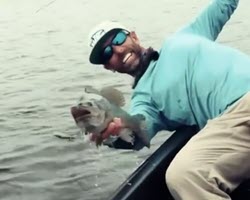
This is the first part of a series on a rig that has revolutionized bass fishing rigs. At one time it was called the leadered punch shot rig. But, now everyone calls it the Tokyo rig.
Here’s the general idea: The line from your reel attaches to a barrel swivel. Attached to the swivel is a welded O-ring. It’s not a split ring. It’s solid. It’s closed. Also attached to the O-ring is the hook. Now, over the next few weeks we’ll talk about what kind of hook we want to use.
VMC has four setups with different style hooks so all you have to do is take the appropriate one out of the package. It’s simple. They’re inexpensive, too. Two of them are less than four dollars and the other two are less than five dollars.
Running off the bottom of the O-ring is a wire leader, maybe 3 inches long with no weight on it. It’s just a straight wire. When you get ready to fish you can thread the weight — any weight, any style — into the wire and bend the wire at the bottom to keep it from falling off. Depending on how you want to fish you can let it slide up and down the wire or fix it so it’s in place at the bottom and doesn’t move.
What are the benefits?
- Better action. Because your bait is on an o-ring it has complete fluidity of movement. It will move 360 degrees in a vertical or horizontal circle. That makes it look more natural.
- The weight is away from the bait. The separation makes a big difference in the bait’s action and movement as well as giving you an increased hookup percentage. The weight will never get in the way of your hook. The weight will never force the fish’s mouth open.
- Overall, you’ll catch 20 percent more fish.

VMC Tokyo Rig Heavy Duty Flippin Hook
The first method to fish a Tokyo rig is to flip and pitch heavy cover with it. This is what I learned in Japan 7 or 8 years ago when I went there. It was good then. It’s good now. I use the rig from VMC that’s called the Tokyo Rig Heavy Duty Flippin Hook. You can get it with a 3/0, 4/0 or 5/0 hook. I usually start with the 3/0 size.
My weight will be a 3/4-ounce tungsten VMC Tungsten Flippin Weight or a VMC Tungsten Worm Weight when I want to go a little lighter. I put either one of them on with the point down. I make a little R-bend in the wire to hold my weight in place. And, usually I’ll bend it all the way around and close it up tight. That keeps it on the wire and keeps it free to move up and down. That freedom of movement keeps my bait fluid on the hook and it lets me quickly change my weight as I fish different types of cover.

I use the same baits as I would with a conventional flipping and pitching rig. My favorite is a beaver-style bait, the Berkley Powerbait Bunker Hawg. I Texas rig it on the hook.
This setup does two things besides what I mentioned above. The first is that you get better penetration through the cover and the wire keeps the bait up, off the bottom. It doesn’t go into the mud like other rigs. The second is that the bait tends to stay cleaner as it passes through the heavy cover. That gives it more action which makes it more attractive to the fish.
You don’t need special tackle for the Tokyo rig. The same rod, reel and line you use now for conventional flipping and pitching is perfect. For me that’s a 7-foot, 6-inch or 8-foot medium-heavy or heavy action rod with 20 or 25-pound-test fluorocarbon or 50- or 60-pound-test braid spooled on my favorite flipping and pitching reel.

44
I’m a fan of the old ways. They were good in the past and they’re good now. But, that doesn’t mean we can’t learn new tricks that are just as good or better. Give the Tokyo rig a try this year. It won’t take long for you to understand why I’m in love with it.
Hear Mike explain the Tokyo Rig:

















